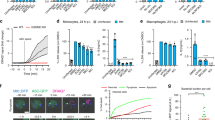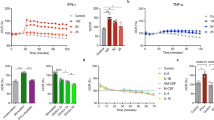Abstract
Induction of macrophage necrosis is a strategy used by virulent Mycobacterium tuberculosis (Mtb) to avoid innate host defense. In contrast, attenuated Mtb causes apoptosis, which limits bacterial replication and promotes T cell cross-priming by antigen-presenting cells. Here we show that Mtb infection causes plasma membrane microdisruptions. Resealing of these lesions, a process crucial for preventing necrosis and promoting apoptosis, required translocation of lysosomal and Golgi apparatus–derived vesicles to the plasma membrane. Plasma membrane repair depended on prostaglandin E2 (PGE2), which regulates synaptotagmin 7 (Syt-7), the calcium sensor involved in the lysosome-mediated repair mechanism. By inducing production of lipoxin A4 (LXA4), which blocks PGE2 biosynthesis, virulent Mtb prevented membrane repair and induced necrosis. Thus, virulent Mtb impairs macrophage plasma membrane repair to evade host defenses.
This is a preview of subscription content, access via your institution
Access options
Subscribe to this journal
Receive 12 print issues and online access
$209.00 per year
only $17.42 per issue
Buy this article
- Purchase on Springer Link
- Instant access to full article PDF
Prices may be subject to local taxes which are calculated during checkout







Similar content being viewed by others
Accession codes
References
McNeil, P.L. & Steinhardt, R.A. Plasma membrane disruption: repair, prevention, adaptation. Annu. Rev. Cell Dev. Biol. 19, 697–731 (2003).
Roy, D. et al. A process for controlling intracellular bacterial infections induced by membrane injury. Science 304, 1515–1518 (2004).
Smith, J. et al. Evidence for pore formation in host cell membranes by ESX-1-secreted ESAT-6 and its role in Mycobacterium marinum escape from the vacuole. Infect. Immun. 76, 5478–5487 (2008).
Bi, G.Q., Alderton, J.M. & Steinhardt, R.A. Calcium-regulated exocytosis is required for cell membrane resealing. J. Cell Biol. 131, 1747–1758 (1995).
Togo, T., Alderton, J.M., Bi, G.Q. & Steinhardt, R.A. The mechanism of facilitated cell membrane resealing. J. Cell Sci. 112, 719–731 (1999).
Rodriguez, A., Webster, P., Ortego, J. & Andrews, N.W. Lysosomes behave as Ca2+-regulated exocytic vesicles in fibroblasts and epithelial cells. J. Cell Biol. 137, 93–104 (1997).
Martinez, I. et al. Synaptotagmin VII regulates Ca2+-dependent exocytosis of lysosomes in fibroblasts. J. Cell Biol. 148, 1141–1149 (2000).
Martens, S. & McMahon, H.T. Mechanisms of membrane fusion: disparate players and common principles. Nat. Rev. Mol. Cell Biol. 9, 543–556 (2008).
Sudhof, T.C. Synaptotagmins: why so many? J. Biol. Chem. 277, 7629–7632 (2002).
Craxton, M. & Goedert, M. Alternative splicing of synaptotagmins involving transmembrane exon skipping. FEBS Lett. 460, 417–422 (1999).
Burgoyne, R.D., O'Callaghan, D.W., Hasdemir, B., Haynes, L.P. & Tepikin, A.V. Neuronal Ca2+-sensor proteins: multitalented regulators of neuronal function. Trends Neurosci. 27, 203–209 (2004).
Bourne, Y., Dannenberg, J., Pollmann, V., Marchot, P. & Pongs, O. Immunocytochemical localization and crystal structure of human frequenin (neuronal calcium sensor 1). J. Biol. Chem. 276, 11949–11955 (2001).
Haynes, L.P., Thomas, G.M. & Burgoyne, R.D. Interaction of neuronal calcium sensor-1 and ADP-ribosylation factor 1 allows bidirectional control of phosphatidylinositol 4-kinase β and trans-Golgi network-plasma membrane traffic. J. Biol. Chem. 280, 6047–6054 (2005).
Armstrong, J.A. & Hart, P.D. Response of cultured macrophages to Mycobacterium tuberculosis, with observations on fusion of lysosomes with phagosomes. J. Exp. Med. 134, 713–740 (1971).
Schaible, U.E. et al. Apoptosis facilitates antigen presentation to T lymphocytes through MHC-I and CD1 in tuberculosis. Nat. Med. 9, 1039–1046 (2003).
Chen, M. et al. Lipid mediators in innate immunity against tuberculosis: opposing roles of PGE2 and LXA4 in the induction of macrophage death. J. Exp. Med. 205, 2791–2801 (2008).
Bafica, A. et al. Host control of Mycobacterium tuberculosis is regulated by 5-lipoxygenase–dependent lipoxin production. J. Clin. Invest. 115, 1601–1606 (2005).
Herb, F. et al. ALOX5 variants associated with susceptibility to human pulmonary tuberculosis. Hum. Mol. Genet. 17, 1052–1060 (2008).
Abdallah, A.M. et al. Type VII secretion—mycobacteria show the way. Nat. Rev. Microbiol. 5, 883–891 (2007).
Hsu, T. et al. The primary mechanism of attenuation of bacillus Calmette-Guerin is a loss of secreted lytic function required for invasion of lung interstitial tissue. Proc. Natl. Acad. Sci. USA 100, 12420–12425 (2003).
Chakrabarti, S. et al. Impaired membrane resealing and autoimmune myositis in synaptotagmin VII–deficient mice. J. Cell Biol. 162, 543–549 (2003).
Terasaki, M., Miyake, K. & McNeil, P.L. Large plasma membrane disruptions are rapidly resealed by Ca2+-dependent vesicle-vesicle fusion events. J. Cell Biol. 139, 63–74 (1997).
McNeil, P.L. Incorporation of macromolecules into living cells. Methods Cell Biol. 29, 153–173 (1989).
Granger, B.L. et al. Characterization and cloning of lgp110, a lysosomal membrane glycoprotein from mouse and rat cells. J. Biol. Chem. 265, 12036–12043 (1990).
Reddy, A., Caler, E.V. & Andrews, N.W. Plasma membrane repair is mediated by Ca2+-regulated exocytosis of lysosomes. Cell 106, 157–169 (2001).
Novikoff, P.M., Tulsiani, D.R., Touster, O., Yam, A. & Novikoff, A.B. Immunocytochemical localization of α-d-mannosidase II in the Golgi apparatus of rat liver. Proc. Natl. Acad. Sci. USA 80, 4364–4368 (1983).
Hart, D.N., Starling, G.C., Calder, V.L. & Fernando, N.S. B7/BB-1 is a leucocyte differentiation antigen on human dendritic cells induced by activation. Immunology 79, 616–620 (1993).
Lin, H.Y. et al. The 170-kDa glucose-regulated stress protein is an endoplasmic reticulum protein that binds immunoglobulin. Mol. Biol. Cell 4, 1109–1119 (1993).
Gan, H. et al. Mycobacterium tuberculosis blocks crosslinking of annexin-1 and apoptotic envelope formation on infected macrophages to maintain virulence. Nat. Immunol. 9, 1189–1197 (2008).
Chen, M., Gan, H. & Remold, H.G. A mechanism of virulence: virulent Mycobacterium tuberculosis strain H37Rv, but not attenuated H37Ra, causes significant mitochondrial inner membrane disruption in macrophages leading to necrosis. J. Immunol. 176, 3707–3716 (2006).
Klausner, R.D., Donaldson, J.G. & Lippincott-Schwartz, J. Brefeldin A: insights into the control of membrane traffic and organelle structure. J. Cell Biol. 116, 1071–1080 (1992).
O'Callaghan, D.W. et al. Differential use of myristoyl groups on neuronal calcium sensor proteins as a determinant of spatio-temporal aspects of Ca2+ signal transduction. J. Biol. Chem. 277, 14227–14237 (2002).
Togo, T., Alderton, J.M. & Steinhardt, R.A. Long-term potentiation of exocytosis and cell membrane repair in fibroblasts. Mol. Biol. Cell 14, 93–106 (2003).
Rodriguez, A., Martinez, I., Chung, A., Berlot, C.H. & Andrews, N.W. cAMP regulates Ca2+-dependent exocytosis of lysosomes and lysosome-mediated cell invasion by trypanosomes. J. Biol. Chem. 274, 16754–16759 (1999).
Regan, J.W. EP2 and EP4 prostanoid receptor signaling. Life Sci. 74, 143–153 (2003).
Fujino, H., West, K.A. & Regan, J.W. Phosphorylation of glycogen synthase kinase-3 and stimulation of T-cell factor signaling following activation of EP2 and EP4 prostanoid receptors by prostaglandin E2 . J. Biol. Chem. 277, 2614–2619 (2002).
Simpson, C.S. & Morris, B.J. Induction of c-fos and zif/268 gene expression in rat striatal neurons, following stimulation of D1-like dopamine receptors, involves protein kinase A and protein kinase C. Neuroscience 68, 97–106 (1995).
Vlahos, C.J., Matter, W.F., Hui, K.Y. & Brown, R.F. A specific inhibitor of phosphatidylinositol 3-kinase, 2-(4-morpholinyl)-8-phenyl-4H–1-benzopyran-4-one (LY294002). J. Biol. Chem. 269, 5241–5248 (1994).
Fujino, H., Salvi, S. & Regan, J.W. Differential regulation of phosphorylation of the cAMP response element-binding protein after activation of EP2 and EP4 prostanoid receptors by prostaglandin E2 . Mol. Pharmacol. 68, 251–259 (2005).
Fujino, H., Xu, W. & Regan, J.W. Prostaglandin E2 induced functional expression of early growth response factor-1 by EP4, but not EP2, prostanoid receptors via the phosphatidylinositol 3-kinase and extracellular signal-regulated kinases. J. Biol. Chem. 278, 12151–12156 (2003).
Hinchey, J. et al. Enhanced priming of adaptive immunity by a proapoptotic mutant of Mycobacterium tuberculosis. J. Clin. Invest. 117, 2279–2288 (2007).
Winau, F. et al. Apoptotic vesicles crossprime CD8 T cells and protect against tuberculosis. Immunity 24, 105–117 (2006).
Deretic, V. et al. Mycobacterium tuberculosis inhibition of phagolysosome biogenesis and autophagy as a host defence mechanism. Cell. Microbiol. 8, 719–727 (2006).
Vergne, I. et al. Mechanism of phagolysosome biogenesis block by viable Mycobacterium tuberculosis. Proc. Natl. Acad. Sci. USA 102, 4033–4038 (2005).
van der Wel, N.N. et al. M. tuberculosis and M. leprae translocate from the phagolysosome to the cytosol in myeloid cells. Cell 129, 1287–1298 (2007).
Sada-Ovalle, I., Chiba, A., Gonzales, A., Brenner, M.B. & Behar, S.M. Innate invariant NKT cells recognize Mycobacterium tuberculosis–infected macrophages, produce interferon-γ, and kill intracellular bacteria. PLoS Pathog. 4, e1000239 (2008).
Woodworth, J.S., Wu, Y. & Behar, S.M. Mycobacterium tuberculosis–specific CD8+ T cells require perforin to kill target cells and provide protection in vivo. J. Immunol. 181, 8595–8603 (2008).
Divangahi, M. et al. NOD2-deficient mice have impaired resistance to Mycobacterium tuberculosis infection through defective innate and adaptive immunity. J. Immunol. 181, 7157–7165 (2008).
Acknowledgements
We thank I-C. Ho for critical reading of the manuscript; and B. Koller (University of North Carolina) for Ptges−/− mice. Supported by the US National Institutes of Health (AI50216 and AI072143 to H.G.R.) and the Fonds de la Recherche en Santé du Québec (M.D.).
Author information
Authors and Affiliations
Contributions
S.M.B., H.G.R. and M.D. conceived of and designed the experiments, analyzed the data and wrote the paper; M.D., M.C. and H.G. did the experiments with assistance from D.D.; T.T.H. did confocal microscopy; and D.M.L. and S.F. provided reagents and intellectual input.
Corresponding authors
Supplementary information
Supplementary Text and Figures
Supplementary Figures 1–3 (PDF 5151 kb)
Rights and permissions
About this article
Cite this article
Divangahi, M., Chen, M., Gan, H. et al. Mycobacterium tuberculosis evades macrophage defenses by inhibiting plasma membrane repair. Nat Immunol 10, 899–906 (2009). https://doi.org/10.1038/ni.1758
Received:
Accepted:
Published:
Issue Date:
DOI: https://doi.org/10.1038/ni.1758
This article is cited by
-
Neonatal imprinting of alveolar macrophages via neutrophil-derived 12-HETE
Nature (2023)
-
Role of C-terminal domain of Mycobacterium tuberculosis PE6 (Rv0335c) protein in host mitochondrial stress and macrophage apoptosis
Apoptosis (2023)
-
Early alveolar macrophage response and IL-1R-dependent T cell priming determine transmissibility of Mycobacterium tuberculosis strains
Nature Communications (2022)
-
Triacylglycerol synthesis enhances macrophage inflammatory function
Nature Communications (2020)
-
New insights into the evasion of host innate immunity by Mycobacterium tuberculosis
Cellular & Molecular Immunology (2020)



